Risk Assessment Report: Trading.com Analysis, MBA402 Module
VerifiedAdded on 2022/11/23
|10
|2453
|215
Report
AI Summary
This report presents a detailed risk assessment of the fictional company, Trading.com, as per the MBA402 module requirements. The report analyzes the company's risk profile using a Risk Exposure Calculator, focusing on three key areas: pressure points due to growth (performance, expansion rate, and employee experience), pressure points due to culture (rewards for risk-taking, resistance to bad news, and internal competition), and pressure points due to information management (transaction complexity, diagnostic performance, and decentralized decision-making). The assessment reveals a high-risk exposure for Trading.com, necessitating immediate attention from the top management. The report provides a comprehensive overview of the company's operational and cultural aspects, highlighting potential vulnerabilities and offering insights based on the provided case study, and supported by numerous references. It emphasizes the importance of addressing the identified issues to mitigate the company's risk of failure.

Running head: RISK ASESSMENT REPORT
RISK ASESSMENT REPORT
Name of the Student
Name of the University
Author Note
RISK ASESSMENT REPORT
Name of the Student
Name of the University
Author Note
Paraphrase This Document
Need a fresh take? Get an instant paraphrase of this document with our AI Paraphraser
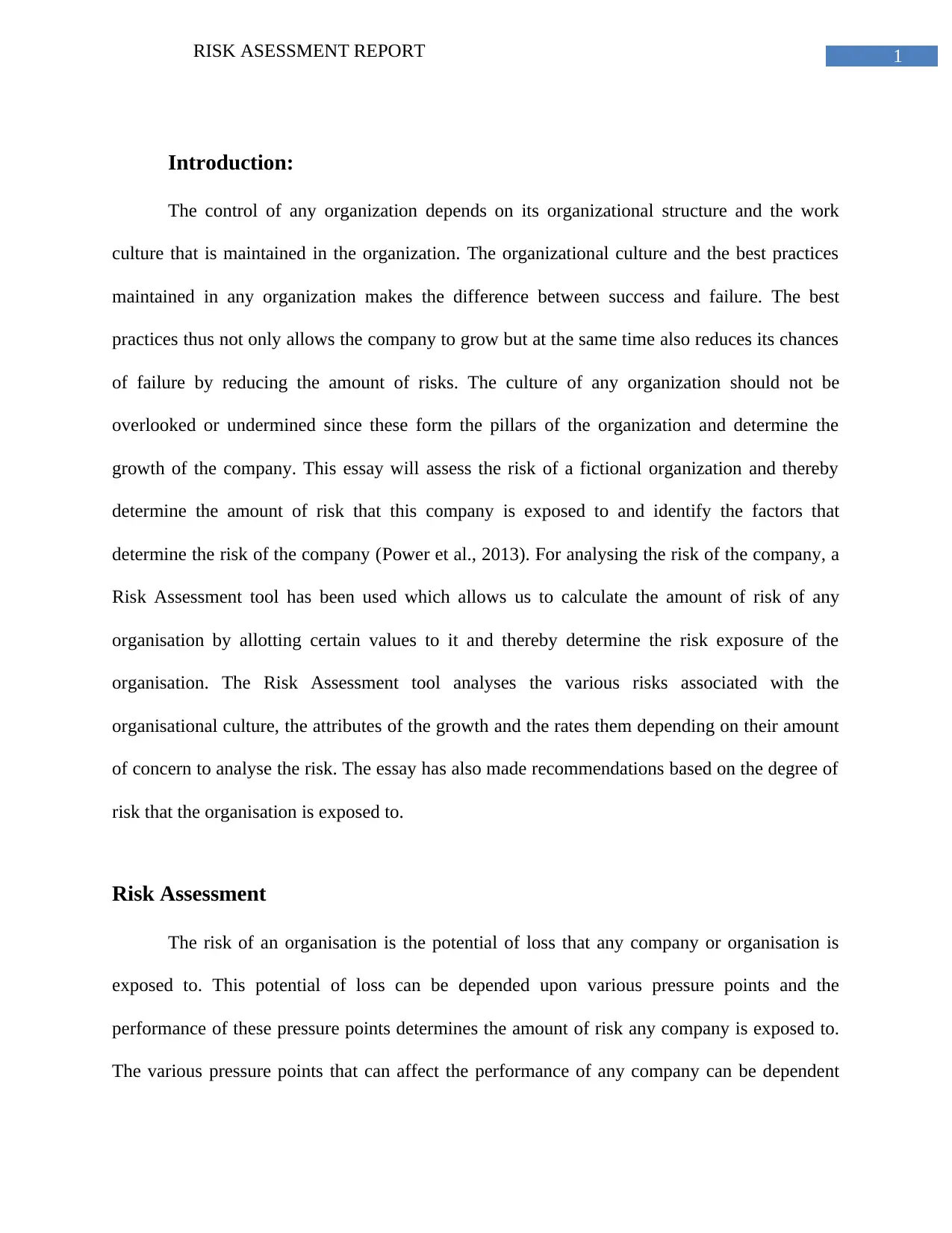
1RISK ASESSMENT REPORT
Introduction:
The control of any organization depends on its organizational structure and the work
culture that is maintained in the organization. The organizational culture and the best practices
maintained in any organization makes the difference between success and failure. The best
practices thus not only allows the company to grow but at the same time also reduces its chances
of failure by reducing the amount of risks. The culture of any organization should not be
overlooked or undermined since these form the pillars of the organization and determine the
growth of the company. This essay will assess the risk of a fictional organization and thereby
determine the amount of risk that this company is exposed to and identify the factors that
determine the risk of the company (Power et al., 2013). For analysing the risk of the company, a
Risk Assessment tool has been used which allows us to calculate the amount of risk of any
organisation by allotting certain values to it and thereby determine the risk exposure of the
organisation. The Risk Assessment tool analyses the various risks associated with the
organisational culture, the attributes of the growth and the rates them depending on their amount
of concern to analyse the risk. The essay has also made recommendations based on the degree of
risk that the organisation is exposed to.
Risk Assessment
The risk of an organisation is the potential of loss that any company or organisation is
exposed to. This potential of loss can be depended upon various pressure points and the
performance of these pressure points determines the amount of risk any company is exposed to.
The various pressure points that can affect the performance of any company can be dependent
Introduction:
The control of any organization depends on its organizational structure and the work
culture that is maintained in the organization. The organizational culture and the best practices
maintained in any organization makes the difference between success and failure. The best
practices thus not only allows the company to grow but at the same time also reduces its chances
of failure by reducing the amount of risks. The culture of any organization should not be
overlooked or undermined since these form the pillars of the organization and determine the
growth of the company. This essay will assess the risk of a fictional organization and thereby
determine the amount of risk that this company is exposed to and identify the factors that
determine the risk of the company (Power et al., 2013). For analysing the risk of the company, a
Risk Assessment tool has been used which allows us to calculate the amount of risk of any
organisation by allotting certain values to it and thereby determine the risk exposure of the
organisation. The Risk Assessment tool analyses the various risks associated with the
organisational culture, the attributes of the growth and the rates them depending on their amount
of concern to analyse the risk. The essay has also made recommendations based on the degree of
risk that the organisation is exposed to.
Risk Assessment
The risk of an organisation is the potential of loss that any company or organisation is
exposed to. This potential of loss can be depended upon various pressure points and the
performance of these pressure points determines the amount of risk any company is exposed to.
The various pressure points that can affect the performance of any company can be dependent
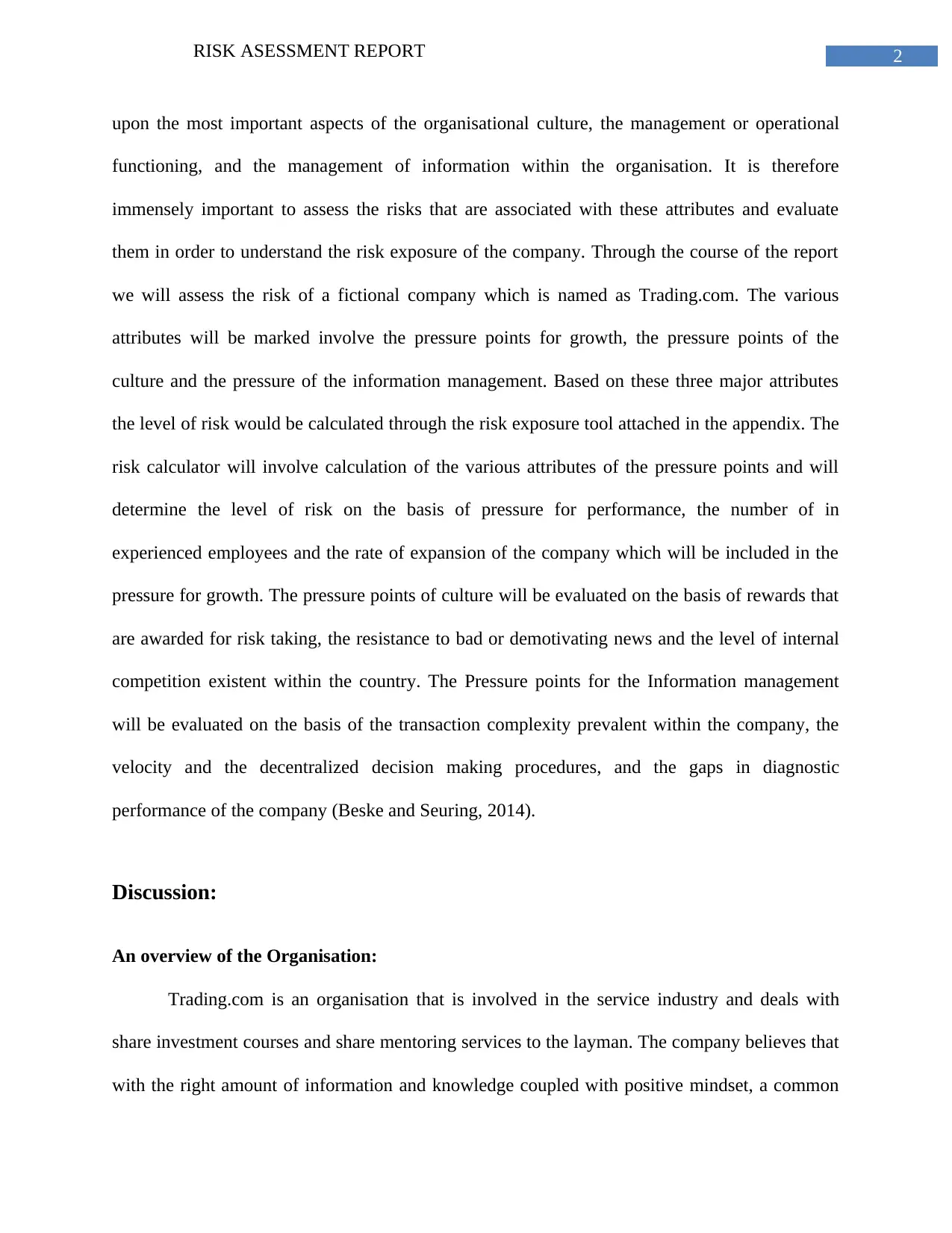
2RISK ASESSMENT REPORT
upon the most important aspects of the organisational culture, the management or operational
functioning, and the management of information within the organisation. It is therefore
immensely important to assess the risks that are associated with these attributes and evaluate
them in order to understand the risk exposure of the company. Through the course of the report
we will assess the risk of a fictional company which is named as Trading.com. The various
attributes will be marked involve the pressure points for growth, the pressure points of the
culture and the pressure of the information management. Based on these three major attributes
the level of risk would be calculated through the risk exposure tool attached in the appendix. The
risk calculator will involve calculation of the various attributes of the pressure points and will
determine the level of risk on the basis of pressure for performance, the number of in
experienced employees and the rate of expansion of the company which will be included in the
pressure for growth. The pressure points of culture will be evaluated on the basis of rewards that
are awarded for risk taking, the resistance to bad or demotivating news and the level of internal
competition existent within the country. The Pressure points for the Information management
will be evaluated on the basis of the transaction complexity prevalent within the company, the
velocity and the decentralized decision making procedures, and the gaps in diagnostic
performance of the company (Beske and Seuring, 2014).
Discussion:
An overview of the Organisation:
Trading.com is an organisation that is involved in the service industry and deals with
share investment courses and share mentoring services to the layman. The company believes that
with the right amount of information and knowledge coupled with positive mindset, a common
upon the most important aspects of the organisational culture, the management or operational
functioning, and the management of information within the organisation. It is therefore
immensely important to assess the risks that are associated with these attributes and evaluate
them in order to understand the risk exposure of the company. Through the course of the report
we will assess the risk of a fictional company which is named as Trading.com. The various
attributes will be marked involve the pressure points for growth, the pressure points of the
culture and the pressure of the information management. Based on these three major attributes
the level of risk would be calculated through the risk exposure tool attached in the appendix. The
risk calculator will involve calculation of the various attributes of the pressure points and will
determine the level of risk on the basis of pressure for performance, the number of in
experienced employees and the rate of expansion of the company which will be included in the
pressure for growth. The pressure points of culture will be evaluated on the basis of rewards that
are awarded for risk taking, the resistance to bad or demotivating news and the level of internal
competition existent within the country. The Pressure points for the Information management
will be evaluated on the basis of the transaction complexity prevalent within the company, the
velocity and the decentralized decision making procedures, and the gaps in diagnostic
performance of the company (Beske and Seuring, 2014).
Discussion:
An overview of the Organisation:
Trading.com is an organisation that is involved in the service industry and deals with
share investment courses and share mentoring services to the layman. The company believes that
with the right amount of information and knowledge coupled with positive mindset, a common
⊘ This is a preview!⊘
Do you want full access?
Subscribe today to unlock all pages.

Trusted by 1+ million students worldwide

3RISK ASESSMENT REPORT
person can also be a share investor and can successfully handle the profile as a professional
investor. Jospe Drake had founded the company three years back and have built a considerable
market by now. The company started scaling up and have offices in Melbourne Adelaide,
Sydney and Brisbane. The company has grown considerably with a total staff of around 100
people and the major reason behind such expansion is the immense success of the product but
also this has led to the unplanned expansion at a rate which affected their performance. In fact
the company has been expanding without even looking at the available resources and have
expanded without taking into account the consequences. The company have expanded without
adequate resources and an unchecked expansion has led to detrimental growth of the company
which has exposed the company to immense risk. In the following sections we will discuss in
detail about the various pressure points that have led to the present conditions (Aebi et al., 2012).
A. Pressure points due to growth
The Pressure points owing to growth refers to the issues that develop due to the
exponential growth of an organisation. The growth of any organisation is associated with the
increase in business, increase in expenditure, and increase in the number of employees which
eventually relate to the organisational growth. With such growth the organisation faces several
issues related with staff management, performance and return on investment. The increasing
growth of any organisation leads to the development of certain issues which include the pressure
of performing (Bromiley et al., 2015). With the increase in growth, the performance pressure on
employees increases. Given the scenario of the Trading.com, the performance pressure of the
employees is high and can be rated as 5 on the Risk calculator. The rate of expansion is the
second attribute that leads to pressure due to growth. The rate of expansion of Trading.com is
also very high and can be rated as 4. Trading.com has expanded greatly within a very short span
person can also be a share investor and can successfully handle the profile as a professional
investor. Jospe Drake had founded the company three years back and have built a considerable
market by now. The company started scaling up and have offices in Melbourne Adelaide,
Sydney and Brisbane. The company has grown considerably with a total staff of around 100
people and the major reason behind such expansion is the immense success of the product but
also this has led to the unplanned expansion at a rate which affected their performance. In fact
the company has been expanding without even looking at the available resources and have
expanded without taking into account the consequences. The company have expanded without
adequate resources and an unchecked expansion has led to detrimental growth of the company
which has exposed the company to immense risk. In the following sections we will discuss in
detail about the various pressure points that have led to the present conditions (Aebi et al., 2012).
A. Pressure points due to growth
The Pressure points owing to growth refers to the issues that develop due to the
exponential growth of an organisation. The growth of any organisation is associated with the
increase in business, increase in expenditure, and increase in the number of employees which
eventually relate to the organisational growth. With such growth the organisation faces several
issues related with staff management, performance and return on investment. The increasing
growth of any organisation leads to the development of certain issues which include the pressure
of performing (Bromiley et al., 2015). With the increase in growth, the performance pressure on
employees increases. Given the scenario of the Trading.com, the performance pressure of the
employees is high and can be rated as 5 on the Risk calculator. The rate of expansion is the
second attribute that leads to pressure due to growth. The rate of expansion of Trading.com is
also very high and can be rated as 4. Trading.com has expanded greatly within a very short span
Paraphrase This Document
Need a fresh take? Get an instant paraphrase of this document with our AI Paraphraser
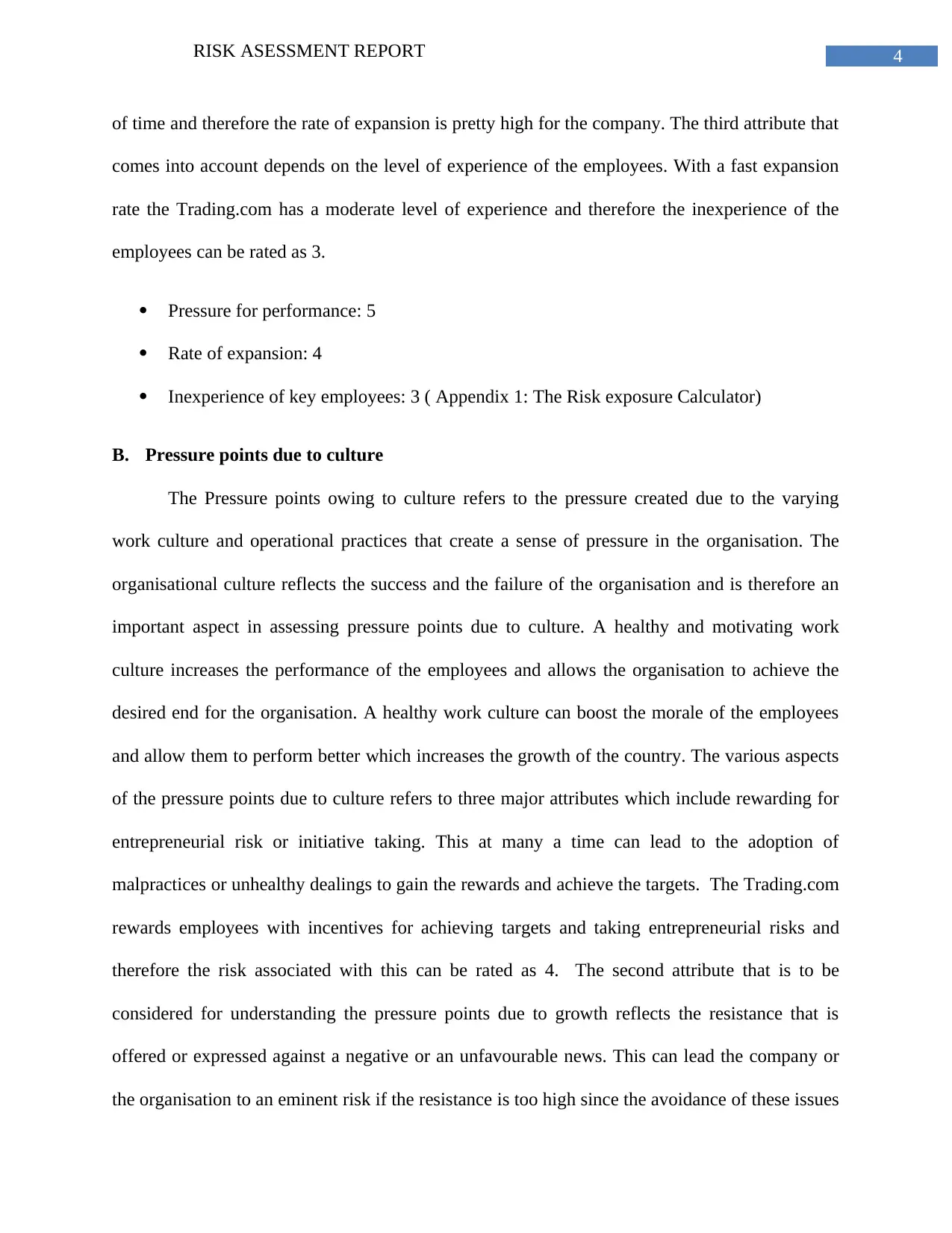
4RISK ASESSMENT REPORT
of time and therefore the rate of expansion is pretty high for the company. The third attribute that
comes into account depends on the level of experience of the employees. With a fast expansion
rate the Trading.com has a moderate level of experience and therefore the inexperience of the
employees can be rated as 3.
Pressure for performance: 5
Rate of expansion: 4
Inexperience of key employees: 3 ( Appendix 1: The Risk exposure Calculator)
B. Pressure points due to culture
The Pressure points owing to culture refers to the pressure created due to the varying
work culture and operational practices that create a sense of pressure in the organisation. The
organisational culture reflects the success and the failure of the organisation and is therefore an
important aspect in assessing pressure points due to culture. A healthy and motivating work
culture increases the performance of the employees and allows the organisation to achieve the
desired end for the organisation. A healthy work culture can boost the morale of the employees
and allow them to perform better which increases the growth of the country. The various aspects
of the pressure points due to culture refers to three major attributes which include rewarding for
entrepreneurial risk or initiative taking. This at many a time can lead to the adoption of
malpractices or unhealthy dealings to gain the rewards and achieve the targets. The Trading.com
rewards employees with incentives for achieving targets and taking entrepreneurial risks and
therefore the risk associated with this can be rated as 4. The second attribute that is to be
considered for understanding the pressure points due to growth reflects the resistance that is
offered or expressed against a negative or an unfavourable news. This can lead the company or
the organisation to an eminent risk if the resistance is too high since the avoidance of these issues
of time and therefore the rate of expansion is pretty high for the company. The third attribute that
comes into account depends on the level of experience of the employees. With a fast expansion
rate the Trading.com has a moderate level of experience and therefore the inexperience of the
employees can be rated as 3.
Pressure for performance: 5
Rate of expansion: 4
Inexperience of key employees: 3 ( Appendix 1: The Risk exposure Calculator)
B. Pressure points due to culture
The Pressure points owing to culture refers to the pressure created due to the varying
work culture and operational practices that create a sense of pressure in the organisation. The
organisational culture reflects the success and the failure of the organisation and is therefore an
important aspect in assessing pressure points due to culture. A healthy and motivating work
culture increases the performance of the employees and allows the organisation to achieve the
desired end for the organisation. A healthy work culture can boost the morale of the employees
and allow them to perform better which increases the growth of the country. The various aspects
of the pressure points due to culture refers to three major attributes which include rewarding for
entrepreneurial risk or initiative taking. This at many a time can lead to the adoption of
malpractices or unhealthy dealings to gain the rewards and achieve the targets. The Trading.com
rewards employees with incentives for achieving targets and taking entrepreneurial risks and
therefore the risk associated with this can be rated as 4. The second attribute that is to be
considered for understanding the pressure points due to growth reflects the resistance that is
offered or expressed against a negative or an unfavourable news. This can lead the company or
the organisation to an eminent risk if the resistance is too high since the avoidance of these issues
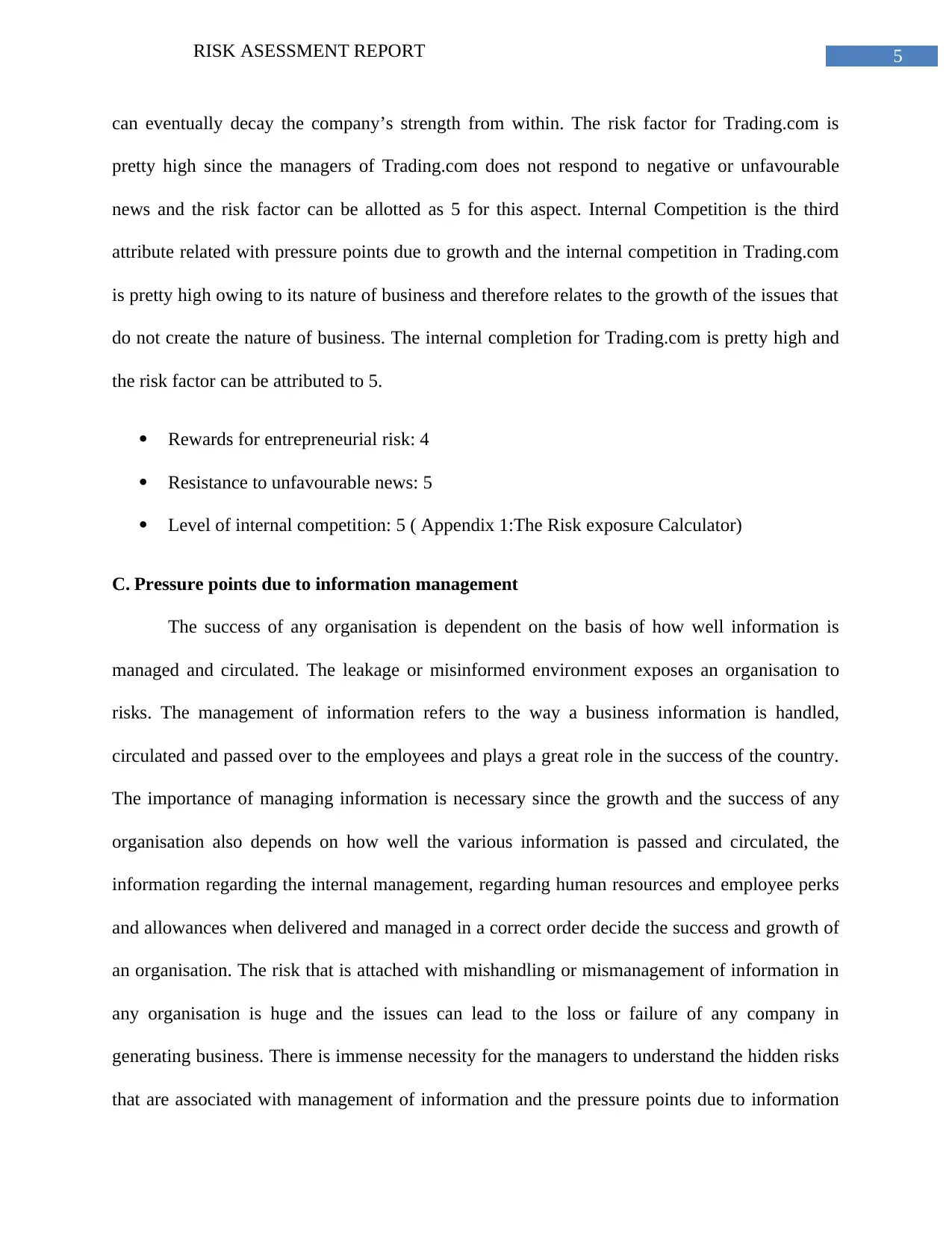
5RISK ASESSMENT REPORT
can eventually decay the company’s strength from within. The risk factor for Trading.com is
pretty high since the managers of Trading.com does not respond to negative or unfavourable
news and the risk factor can be allotted as 5 for this aspect. Internal Competition is the third
attribute related with pressure points due to growth and the internal competition in Trading.com
is pretty high owing to its nature of business and therefore relates to the growth of the issues that
do not create the nature of business. The internal completion for Trading.com is pretty high and
the risk factor can be attributed to 5.
Rewards for entrepreneurial risk: 4
Resistance to unfavourable news: 5
Level of internal competition: 5 ( Appendix 1:The Risk exposure Calculator)
C. Pressure points due to information management
The success of any organisation is dependent on the basis of how well information is
managed and circulated. The leakage or misinformed environment exposes an organisation to
risks. The management of information refers to the way a business information is handled,
circulated and passed over to the employees and plays a great role in the success of the country.
The importance of managing information is necessary since the growth and the success of any
organisation also depends on how well the various information is passed and circulated, the
information regarding the internal management, regarding human resources and employee perks
and allowances when delivered and managed in a correct order decide the success and growth of
an organisation. The risk that is attached with mishandling or mismanagement of information in
any organisation is huge and the issues can lead to the loss or failure of any company in
generating business. There is immense necessity for the managers to understand the hidden risks
that are associated with management of information and the pressure points due to information
can eventually decay the company’s strength from within. The risk factor for Trading.com is
pretty high since the managers of Trading.com does not respond to negative or unfavourable
news and the risk factor can be allotted as 5 for this aspect. Internal Competition is the third
attribute related with pressure points due to growth and the internal competition in Trading.com
is pretty high owing to its nature of business and therefore relates to the growth of the issues that
do not create the nature of business. The internal completion for Trading.com is pretty high and
the risk factor can be attributed to 5.
Rewards for entrepreneurial risk: 4
Resistance to unfavourable news: 5
Level of internal competition: 5 ( Appendix 1:The Risk exposure Calculator)
C. Pressure points due to information management
The success of any organisation is dependent on the basis of how well information is
managed and circulated. The leakage or misinformed environment exposes an organisation to
risks. The management of information refers to the way a business information is handled,
circulated and passed over to the employees and plays a great role in the success of the country.
The importance of managing information is necessary since the growth and the success of any
organisation also depends on how well the various information is passed and circulated, the
information regarding the internal management, regarding human resources and employee perks
and allowances when delivered and managed in a correct order decide the success and growth of
an organisation. The risk that is attached with mishandling or mismanagement of information in
any organisation is huge and the issues can lead to the loss or failure of any company in
generating business. There is immense necessity for the managers to understand the hidden risks
that are associated with management of information and the pressure points due to information
⊘ This is a preview!⊘
Do you want full access?
Subscribe today to unlock all pages.

Trusted by 1+ million students worldwide
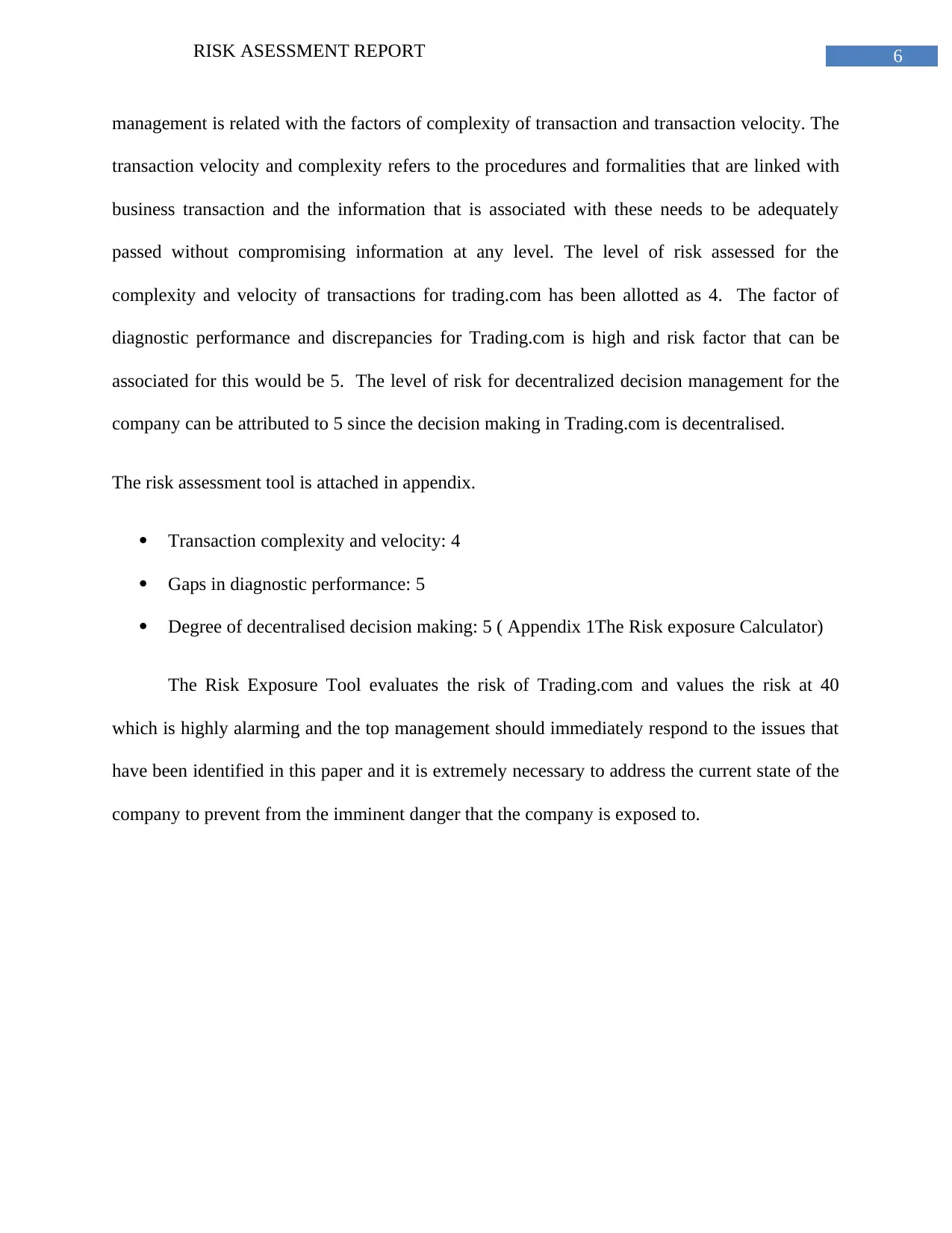
6RISK ASESSMENT REPORT
management is related with the factors of complexity of transaction and transaction velocity. The
transaction velocity and complexity refers to the procedures and formalities that are linked with
business transaction and the information that is associated with these needs to be adequately
passed without compromising information at any level. The level of risk assessed for the
complexity and velocity of transactions for trading.com has been allotted as 4. The factor of
diagnostic performance and discrepancies for Trading.com is high and risk factor that can be
associated for this would be 5. The level of risk for decentralized decision management for the
company can be attributed to 5 since the decision making in Trading.com is decentralised.
The risk assessment tool is attached in appendix.
Transaction complexity and velocity: 4
Gaps in diagnostic performance: 5
Degree of decentralised decision making: 5 ( Appendix 1The Risk exposure Calculator)
The Risk Exposure Tool evaluates the risk of Trading.com and values the risk at 40
which is highly alarming and the top management should immediately respond to the issues that
have been identified in this paper and it is extremely necessary to address the current state of the
company to prevent from the imminent danger that the company is exposed to.
management is related with the factors of complexity of transaction and transaction velocity. The
transaction velocity and complexity refers to the procedures and formalities that are linked with
business transaction and the information that is associated with these needs to be adequately
passed without compromising information at any level. The level of risk assessed for the
complexity and velocity of transactions for trading.com has been allotted as 4. The factor of
diagnostic performance and discrepancies for Trading.com is high and risk factor that can be
associated for this would be 5. The level of risk for decentralized decision management for the
company can be attributed to 5 since the decision making in Trading.com is decentralised.
The risk assessment tool is attached in appendix.
Transaction complexity and velocity: 4
Gaps in diagnostic performance: 5
Degree of decentralised decision making: 5 ( Appendix 1The Risk exposure Calculator)
The Risk Exposure Tool evaluates the risk of Trading.com and values the risk at 40
which is highly alarming and the top management should immediately respond to the issues that
have been identified in this paper and it is extremely necessary to address the current state of the
company to prevent from the imminent danger that the company is exposed to.
Paraphrase This Document
Need a fresh take? Get an instant paraphrase of this document with our AI Paraphraser
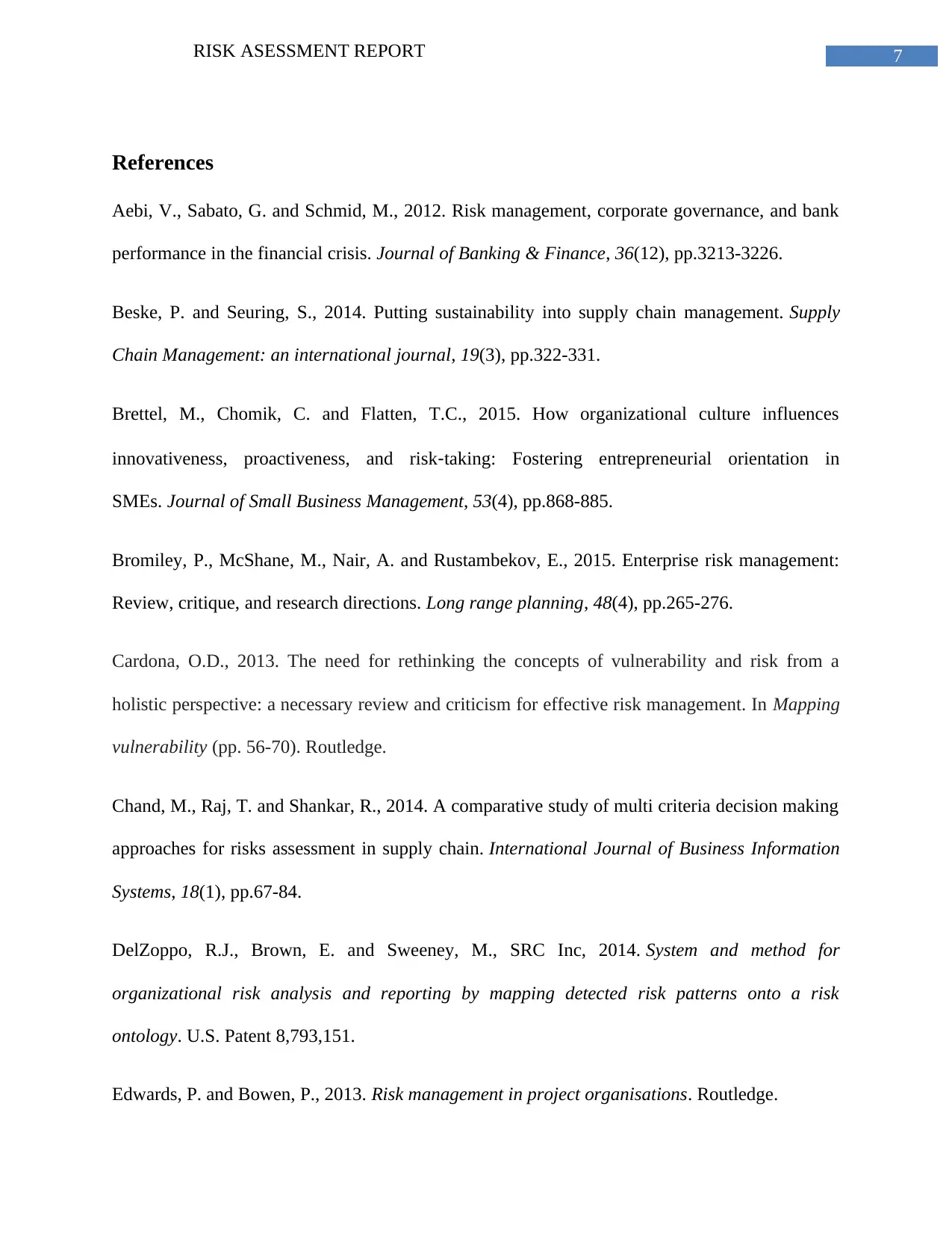
7RISK ASESSMENT REPORT
References
Aebi, V., Sabato, G. and Schmid, M., 2012. Risk management, corporate governance, and bank
performance in the financial crisis. Journal of Banking & Finance, 36(12), pp.3213-3226.
Beske, P. and Seuring, S., 2014. Putting sustainability into supply chain management. Supply
Chain Management: an international journal, 19(3), pp.322-331.
Brettel, M., Chomik, C. and Flatten, T.C., 2015. How organizational culture influences
innovativeness, proactiveness, and risk‐taking: Fostering entrepreneurial orientation in
SMEs. Journal of Small Business Management, 53(4), pp.868-885.
Bromiley, P., McShane, M., Nair, A. and Rustambekov, E., 2015. Enterprise risk management:
Review, critique, and research directions. Long range planning, 48(4), pp.265-276.
Cardona, O.D., 2013. The need for rethinking the concepts of vulnerability and risk from a
holistic perspective: a necessary review and criticism for effective risk management. In Mapping
vulnerability (pp. 56-70). Routledge.
Chand, M., Raj, T. and Shankar, R., 2014. A comparative study of multi criteria decision making
approaches for risks assessment in supply chain. International Journal of Business Information
Systems, 18(1), pp.67-84.
DelZoppo, R.J., Brown, E. and Sweeney, M., SRC Inc, 2014. System and method for
organizational risk analysis and reporting by mapping detected risk patterns onto a risk
ontology. U.S. Patent 8,793,151.
Edwards, P. and Bowen, P., 2013. Risk management in project organisations. Routledge.
References
Aebi, V., Sabato, G. and Schmid, M., 2012. Risk management, corporate governance, and bank
performance in the financial crisis. Journal of Banking & Finance, 36(12), pp.3213-3226.
Beske, P. and Seuring, S., 2014. Putting sustainability into supply chain management. Supply
Chain Management: an international journal, 19(3), pp.322-331.
Brettel, M., Chomik, C. and Flatten, T.C., 2015. How organizational culture influences
innovativeness, proactiveness, and risk‐taking: Fostering entrepreneurial orientation in
SMEs. Journal of Small Business Management, 53(4), pp.868-885.
Bromiley, P., McShane, M., Nair, A. and Rustambekov, E., 2015. Enterprise risk management:
Review, critique, and research directions. Long range planning, 48(4), pp.265-276.
Cardona, O.D., 2013. The need for rethinking the concepts of vulnerability and risk from a
holistic perspective: a necessary review and criticism for effective risk management. In Mapping
vulnerability (pp. 56-70). Routledge.
Chand, M., Raj, T. and Shankar, R., 2014. A comparative study of multi criteria decision making
approaches for risks assessment in supply chain. International Journal of Business Information
Systems, 18(1), pp.67-84.
DelZoppo, R.J., Brown, E. and Sweeney, M., SRC Inc, 2014. System and method for
organizational risk analysis and reporting by mapping detected risk patterns onto a risk
ontology. U.S. Patent 8,793,151.
Edwards, P. and Bowen, P., 2013. Risk management in project organisations. Routledge.

8RISK ASESSMENT REPORT
Fadun, O.S., 2013. Risk management and risk management failure: Lessons for business
enterprises. International Journal of Academic Research in Business and Social Sciences, 3(2),
p.225.
Kayworth, T. and Whitten, D., 2012. Effective information security requires a balance of social
and technology factors.
Power, M., Ashby, S. and Palermo, T., 2013. Risk culture in financial organisations: A research
report. CARR-Analysis of Risk and Regulation.
Simons, R. (2018). How Risky Is Your Company?. [online] Harvard Business Review. Available
at: https://hbr.org/1999/05/how-risky-is-your-company [Accessed 28 Sep. 2018].
Simons, R., 2014. Choosing the right customer. Harvard Business Review, 92(3), pp.48-55.
Teece, D., Peteraf, M. and Leih, S., 2016. Dynamic capabilities and organizational agility: Risk,
uncertainty, and strategy in the innovation economy. California Management Review, 58(4),
pp.13-35.
Thalmann, S., Manhart, M., Ceravolo, P. and Azzini, A., 2014. An integrated risk management
framework: measuring the success of organizational knowledge protection. International Journal
of Knowledge Management (IJKM), 10(2), pp.28-42.
Ulaga, W. and Loveland, J.M., 2014. Transitioning from product to service-led growth in
manufacturing firms: Emergent challenges in selecting and managing the industrial sales
force. Industrial Marketing Management, 43(1), pp.113-125.
Fadun, O.S., 2013. Risk management and risk management failure: Lessons for business
enterprises. International Journal of Academic Research in Business and Social Sciences, 3(2),
p.225.
Kayworth, T. and Whitten, D., 2012. Effective information security requires a balance of social
and technology factors.
Power, M., Ashby, S. and Palermo, T., 2013. Risk culture in financial organisations: A research
report. CARR-Analysis of Risk and Regulation.
Simons, R. (2018). How Risky Is Your Company?. [online] Harvard Business Review. Available
at: https://hbr.org/1999/05/how-risky-is-your-company [Accessed 28 Sep. 2018].
Simons, R., 2014. Choosing the right customer. Harvard Business Review, 92(3), pp.48-55.
Teece, D., Peteraf, M. and Leih, S., 2016. Dynamic capabilities and organizational agility: Risk,
uncertainty, and strategy in the innovation economy. California Management Review, 58(4),
pp.13-35.
Thalmann, S., Manhart, M., Ceravolo, P. and Azzini, A., 2014. An integrated risk management
framework: measuring the success of organizational knowledge protection. International Journal
of Knowledge Management (IJKM), 10(2), pp.28-42.
Ulaga, W. and Loveland, J.M., 2014. Transitioning from product to service-led growth in
manufacturing firms: Emergent challenges in selecting and managing the industrial sales
force. Industrial Marketing Management, 43(1), pp.113-125.
⊘ This is a preview!⊘
Do you want full access?
Subscribe today to unlock all pages.

Trusted by 1+ million students worldwide
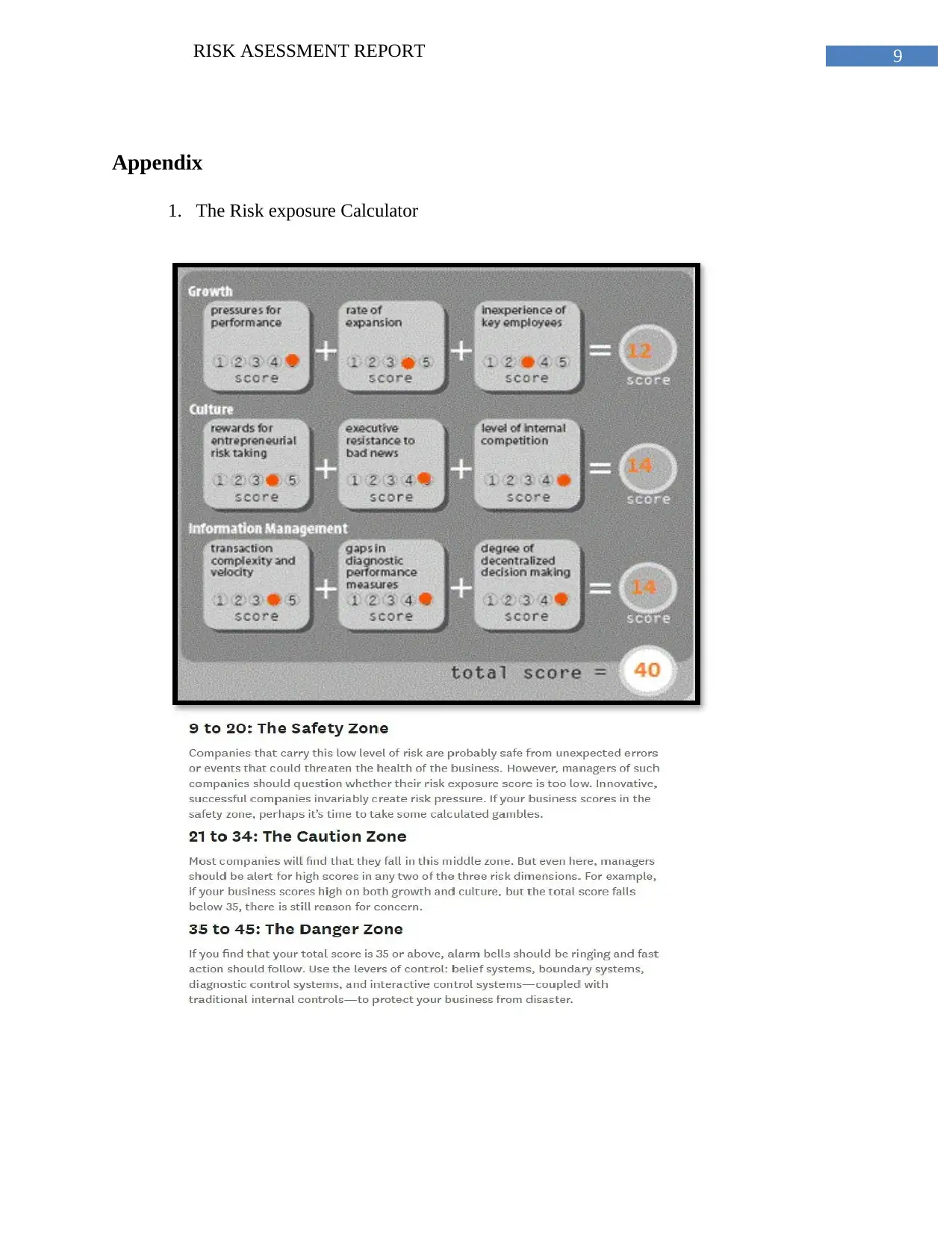
9RISK ASESSMENT REPORT
Appendix
1. The Risk exposure Calculator
Appendix
1. The Risk exposure Calculator
1 out of 10
Related Documents
Your All-in-One AI-Powered Toolkit for Academic Success.
+13062052269
info@desklib.com
Available 24*7 on WhatsApp / Email
![[object Object]](/_next/static/media/star-bottom.7253800d.svg)
Unlock your academic potential
Copyright © 2020–2025 A2Z Services. All Rights Reserved. Developed and managed by ZUCOL.




